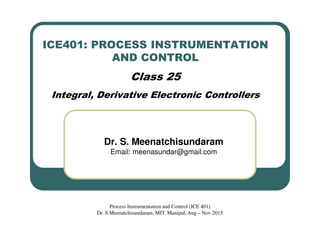
Class 25 i, d electronic controllers
- 1. ICE401: PROCESS INSTRUMENTATION AND CONTROL Class 25 Integral, Derivative Electronic Controllers Dr. S. Meenatchisundaram Email: meenasundar@gmail.com Process Instrumentation and Control (ICE 401) Dr. S.Meenatchisundaram, MIT, Manipal, Aug – Nov 2015
- 2. Integral Control Mode: Process Instrumentation and Control (ICE 401) Dr. S.Meenatchisundaram, MIT, Manipal, Aug – Nov 2015 • Suppose we have an input range of 6 V, an output range of 5 V, and KI = 3.0%/(% ‒ min). • Integral gain is often given in minutes because industrial processes are slow, compared to a time of seconds. • This gain is often expressed as integration time, TI, which is just the inverse of the gain, so TI = 0.33 min or 19.8 sec. • We must first convert the time units to seconds. Therefore • An error of 1% for 1 s is found from (0.01)(6 V)(1 s) = 0.06 V ‒ s 3% 0.05%1min % min 60sec % s = − −
- 3. Integral Control Mode: Process Instrumentation and Control (ICE 401) Dr. S.Meenatchisundaram, MIT, Manipal, Aug – Nov 2015 • Furthermore, KI percent of the output (using the seconds expression for gain) is (0.0005)(5 V) = 0.0025V • Therefore, the integral gain in terms of voltage must be GI=(0.0025V)/(0.06V‒s)=0.0417s-1 • The values of R and C can be selected from this.
- 4. Integral Control Mode: Process Instrumentation and Control (ICE 401) Dr. S.Meenatchisundaram, MIT, Manipal, Aug – Nov 2015 Try: An integral control system will have a measurement range of 0.4 to 2.0 V and an output range of 0 to 6.8 V. Design an op amp integral controller to implement a gain of KI = 4.0%/(% ‒ min). Specify the values of GI, R1 and C. Solution: We must first convert the time units to seconds. Therefore KI percent of the output (using the seconds expression for gain) is (0.000667)(6.8V) = 0.00454 V 4% 0.0667%1min % min 60sec % s = − −
- 5. Integral Control Mode: Process Instrumentation and Control (ICE 401) Dr. S.Meenatchisundaram, MIT, Manipal, Aug – Nov 2015 • An error of 1% for 1 s is found from (0.01)(1.6 V)(1 s) = 0.016 V ‒ s • Therefore, the integral gain in terms of voltage must be GI=(0.00454V)/(0.016V‒s)=0.283s-1 • Since, GI = 1/RC, • RC = 3.524. By selecting C = 100µF, then R = 35.3K .
- 6. Derivative Control Mode: Process Instrumentation and Control (ICE 401) Dr. S.Meenatchisundaram, MIT, Manipal, Aug – Nov 2015 ( ) p D de p t K dt = e out dV V RC dt = − • For a theoretical derivative op-amp circuit,
- 7. Derivative Control Mode: Process Instrumentation and Control (ICE 401) Dr. S.Meenatchisundaram, MIT, Manipal, Aug – Nov 2015 • For a practical derivative op-amp circuit, • From the above equation, the output depends upon the derivative of the input voltage, but there is now an extra term involving the derivative of the output voltage. • Essentially, we have a first-order differential equation relating input and output voltage. • For very high frequencies the impedance of the capacitor becomes very small and can be neglected. • Then the circuit becomes just an inverting amplifier with a gain is ‒ (R2/R1). 1 2 out e out dV dV V R C R C dt dt + = −
- 8. Derivative Control Mode: Process Instrumentation and Control (ICE 401) Dr. S.Meenatchisundaram, MIT, Manipal, Aug – Nov 2015 • At low frequency the impedance of the capacitor will be large so R1 can be neglected. Then, the response of can be given as, • The circuit exhibits a derivative response provided the following inequality is satisfied, i.e, 2 π f R1 C << 1. • The following derivative mode design guidelines can be followed: 1. Estimate the maximum frequency at which the physical system can respond, fmax. 2. Set 2πfmaxR1 C =0.1 and solve for R1. (C is found from the mode derivative gain requirement.) e out dV V RC dt = −
- 9. References: • Process Control Instrumentation Technology, by Curtis D. Johnson, Eighth Edition, Pearson Education Limited. Process Instrumentation and Control (ICE 401) Dr. S.Meenatchisundaram, MIT, Manipal, Aug – Nov 2015
